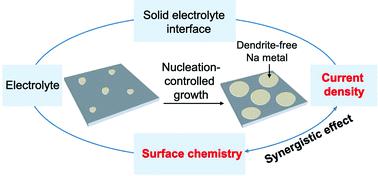当前位置:
X-MOL 学术
›
Chem. Soc. Rev.
›
论文详情
Our official English website, www.x-mol.net, welcomes your
feedback! (Note: you will need to create a separate account there.)
Combining theories and experiments to understand the sodium nucleation behavior towards safe sodium metal batteries.
Chemical Society Reviews ( IF 40.4 ) Pub Date : 2020-05-29 , DOI: 10.1039/d0cs00033g Huan Wang 1 , Edward Matios , Jianmin Luo , Weiyang Li
Chemical Society Reviews ( IF 40.4 ) Pub Date : 2020-05-29 , DOI: 10.1039/d0cs00033g Huan Wang 1 , Edward Matios , Jianmin Luo , Weiyang Li
Affiliation

|
Rechargeable sodium (Na) based batteries have gained tremendous research interest because of the high natural abundance and low cost of Na resources, as well as electrochemical similarities with lithium (Li) based batteries. However, despite the great potential as a candidate for next-generation grid-scale energy storage, the implementation of the Na metal anode has been primarily hindered by dendritic and “dead” Na formation that leads to low Coulombic efficiency, short lifespan and even safety concerns. Na dendrite formation mainly originates from the uncontrolled Na deposition behavior in the absence of nucleation site regulation. Hence, the Na nucleation and initial stage of growth are critically important for the final morphology of Na metal. Here, this tutorial review aims to provide a comprehensive understanding of the importance of the nucleation behavior towards dendrite-free Na metal anodes. Firstly, we start with an introduction about the advantages of Na metal batteries over the Li counterpart and the challenges faced by Na metal anodes. The differences between metallic Li and Na are summarized according to advanced in situ characterization techniques. Next, we elucidate the key factors that influence the Na nucleation and growth behaviors based on the existing theoretical models. Then, we review the state-of-the-art approaches that have been applied to effectively regulate Na nucleation for dendrite-free Na deposition. Lastly, we conclude the review with perspectives on realizing safe Na metal batteries with high energy density.
中文翻译:

结合理论和实验,了解钠对安全钠金属电池的成核行为。
可充电的钠(Na)电池由于其自然资源丰富,钠资源成本低以及与锂(Li)电池的电化学相似性而获得了巨大的研究兴趣。然而,尽管有潜力成为下一代电网规模储能的潜力,但钠金属阳极的实施主要受到树枝状和“死”钠形成的阻碍,导致低库仑效率,短寿命甚至安全关注。Na枝晶的形成主要源于在没有成核位点调节的情况下不受控制的Na沉积行为。因此,Na成核和生长的初始阶段对于Na金属的最终形态至关重要。这里,本教程综述旨在全面理解成核行为对无枝晶的Na金属阳极的重要性。首先,我们首先介绍钠金属电池相对于锂电池的优势以及钠金属阳极所面临的挑战。总结了金属锂和钠之间的差异原位表征技术。接下来,我们根据现有的理论模型阐明影响Na形核和生长行为的关键因素。然后,我们回顾了用于有效调节Na成核的无树突状Na沉积的最新方法。最后,我们以实现高能量密度安全钠金属电池的观点来结束本综述。
更新日期:2020-06-22
中文翻译:

结合理论和实验,了解钠对安全钠金属电池的成核行为。
可充电的钠(Na)电池由于其自然资源丰富,钠资源成本低以及与锂(Li)电池的电化学相似性而获得了巨大的研究兴趣。然而,尽管有潜力成为下一代电网规模储能的潜力,但钠金属阳极的实施主要受到树枝状和“死”钠形成的阻碍,导致低库仑效率,短寿命甚至安全关注。Na枝晶的形成主要源于在没有成核位点调节的情况下不受控制的Na沉积行为。因此,Na成核和生长的初始阶段对于Na金属的最终形态至关重要。这里,本教程综述旨在全面理解成核行为对无枝晶的Na金属阳极的重要性。首先,我们首先介绍钠金属电池相对于锂电池的优势以及钠金属阳极所面临的挑战。总结了金属锂和钠之间的差异原位表征技术。接下来,我们根据现有的理论模型阐明影响Na形核和生长行为的关键因素。然后,我们回顾了用于有效调节Na成核的无树突状Na沉积的最新方法。最后,我们以实现高能量密度安全钠金属电池的观点来结束本综述。











































 京公网安备 11010802027423号
京公网安备 11010802027423号